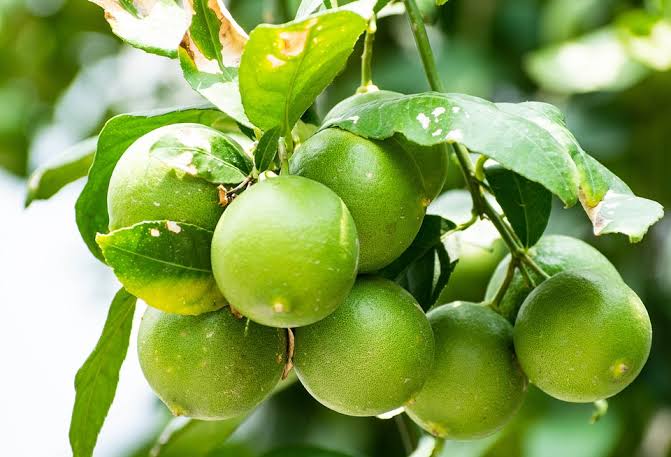Limes fruit which is scientifically known as Citrus aurantiifolia are a type of small, green citrus fruit that many people enjoy for their refreshing taste. These fruits are known for their tangy flavor, which adds a burst of citrusy goodness to various dishes and beverages.
One remarkable thing about limes is their versatility. You can find them in numerous cuisines around the world, enhancing the taste of salads, drinks, and desserts. The zesty juice of limes is often used as a key ingredient in salad dressings, marinades, and sauces, contributing a lively and tangy kick to the overall flavor.
Not only do limes bring a delightful taste to the table, but they also offer a good dose of vitamin C. This essential nutrient is known for its immune-boosting properties, helping to keep our bodies healthy and resilient against illnesses. Including limes in your diet can be a simple and tasty way to support your overall well-being.
In addition to their culinary uses, limes have found their way into various cultural traditions. From garnishing drinks to being a symbolic element in celebrations, limes have become more than just a fruit—they hold cultural significance in many societies.
The citrusy aroma of limes is another delightful aspect that makes them popular. Whether you’re squeezing fresh lime juice for a cocktail or adding a slice to your water, the scent of limes can evoke feelings of freshness and invigoration.
Interestingly, limes come in different varieties, each with its own unique flavor profile. From the common Persian lime to the smaller Key lime, these variations offer subtle differences in taste and aroma. This diversity allows people to choose the type of lime that best suits their culinary preferences.
Growing limes requires specific climatic conditions, typically thriving in warm, tropical environments. This preference has led to the cultivation of lime orchards in various parts of the world, ensuring a steady supply for those who enjoy the vibrant taste of this citrus fruit.
In addition, limes are more than just a green fruit; they are a culinary and cultural delight. Whether you’re savoring their tangy goodness in a refreshing drink or benefiting from their vitamin C content, limes have earned their place as a beloved and versatile ingredient in kitchens worldwide. So, the next time you reach for a lime, appreciate not only its taste but also the rich cultural and nutritional value it brings to your table.
Read Also: Different Systems of Pig Production for Optimum Performance
History of Limes (Citrus aurantiifolia)

Limes have a fascinating history that traces back thousands of years. Originating in Southeast Asia, these small green citrus fruits have traveled across continents, influencing cuisines, trade routes, and cultural practices.
Historically, limes were cultivated in regions like India and Malaysia, and their use can be traced back to ancient civilizations. As seafaring trade routes expanded, limes made their way to the Middle East, North Africa, and eventually Europe, becoming a sought-after commodity.
During the Age of Exploration, European sailors faced the challenge of scurvy—a debilitating disease caused by vitamin C deficiency. Limes, rich in vitamin C, became a crucial component in sailors’ diets, effectively preventing scurvy during long ocean voyages. This connection between limes and scurvy prevention contributed to the nickname “limeys” for British sailors.
In the 18th and 19th centuries, limes played a pivotal role in global trade. The British Navy, recognizing the importance of limes, even issued a daily ration of lime juice to sailors. This historical association with naval health solidified the lime’s place in maritime lore.
As colonial powers expanded their influence, limes were introduced to the Americas, where they found fertile soil and thrived in tropical climates. The cultivation of limes in regions like Mexico and the Caribbean contributed to the integration of limes into local cuisines.
Over time, limes became a staple in various culinary traditions, from the zesty addition to Mexican salsas to the tangy flavoring of Southeast Asian dishes. The versatility of limes in both sweet and savory recipes further cemented their status as a global culinary ingredient.
In contemporary times, limes continue to be a popular and essential part of the culinary landscape. From the iconic key lime pie in the United States to the ubiquitous use of lime in Thai cuisine, these citrus fruits have left an indelible mark on the world’s food culture.
In addition, the history of limes is a journey of culinary exploration, cultural exchange, and maritime health. From their origins in Southeast Asia to becoming a vital component in preventing scurvy during naval expeditions, limes have transcended their geographical roots to become a global culinary phenomenon. Today, their tangy zestiness continues to add vibrancy to dishes worldwide, connecting us to a rich historical tapestry of trade, exploration, and gastronomy.
The Nutritional Value of Limes (Citrus aurantiifolia)

Limes boast a notable nutritional profile, offering a range of vitamins and minerals that contribute to overall health. Here’s a glimpse into the nutritional value of these small citrus fruits:
1. Vitamin C: Limes are renowned for their high vitamin C content, a potent antioxidant that supports the immune system, promotes skin health, and aids in the absorption of iron.
2. Dietary Fiber: Limes contain dietary fiber, which is beneficial for digestive health. Fiber helps regulate bowel movements, prevent constipation, and may contribute to weight management.
3. Vitamin A: Limes provide a modest amount of vitamin A, which is essential for maintaining healthy skin, vision, and immune function.
4. Potassium: Limes contain potassium, an electrolyte that helps regulate fluid balance, muscle contractions, and nerve signals. Adequate potassium intake is crucial for maintaining heart health.
5. Calcium and Magnesium: While not as abundant as in some other fruits, limes do contain small amounts of calcium and magnesium, which are essential for bone health and various physiological processes.
6. Phytonutrients: Limes contain various phytonutrients, including flavonoids, which have antioxidant and anti-inflammatory properties. These compounds contribute to the overall health-promoting effects of limes.
7. Low in Calories: Limes are relatively low in calories, making them a healthy and flavorful addition to a balanced diet. Their vibrant taste allows for the enhancement of dishes without significantly increasing calorie intake.
It’s important to note that while limes offer these nutritional benefits, they are typically consumed in smaller quantities, often as flavor enhancers rather than as a primary source of nutrients. Including a variety of fruits and vegetables in your diet ensures a broader spectrum of essential nutrients.
Additionally, limes are not only prized for their refreshing taste but also for their nutritional richness. Whether enjoyed in beverages, salads, or desserts, limes contribute to overall well-being by providing essential vitamins, minerals, and antioxidants.
Read Also: Inbreeding, Importance and It’s Effect in Pig Farming
Health Benefits of Limes (Citrus aurantiifolia)

Limes come with a range of health benefits, thanks to their nutrient-packed composition. Here are some notable advantages associated with incorporating limes into your diet:
1. Immune System Support: Limes are a rich source of vitamin C, a powerful antioxidant known for its role in supporting the immune system. Adequate vitamin C intake may help reduce the duration and severity of common colds.
2. Skin Health: The antioxidants in limes, including vitamin C, contribute to healthier skin by combating free radicals. These antioxidants help protect the skin from damage caused by the sun and environmental pollutants.
3. Digestive Health: The dietary fiber found in limes aids in digestion and can help prevent constipation. Fiber is essential for maintaining a healthy digestive system and promoting regular bowel movements.
4. Heart Health: Potassium in limes is beneficial for heart health. It helps regulate blood pressure, reducing the risk of cardiovascular diseases. Additionally, the antioxidants in limes may contribute to a lower risk of heart-related issues.
5. Weight Management: Limes are low in calories and can be a flavorful addition to meals and beverages without significantly increasing calorie intake. The natural tanginess of limes can enhance the taste of dishes, making them a great choice for those looking to manage their weight.
6. Anti-Inflammatory Properties: The flavonoids and other phytonutrients in limes have anti-inflammatory properties. Regular consumption may help reduce inflammation in the body, potentially lowering the risk of chronic diseases associated with inflammation.
7. Hydration: Limes, when added to water or other beverages, can encourage increased fluid intake. Staying adequately hydrated is crucial for various bodily functions, including temperature regulation and nutrient transport.
8. Aid in Iron Absorption: Vitamin C in limes enhances the absorption of non-heme iron (found in plant-based foods) when consumed together. This can be particularly beneficial for individuals who follow a vegetarian or vegan diet.
It’s important to note that while limes offer these health benefits, they are most effective as part of a well-balanced diet. Incorporating a variety of fruits and vegetables ensures a diverse range of nutrients for optimal health.
Additionally, limes are not just a flavorful addition to your meals; they also offer a spectrum of health benefits that contribute to overall well-being. Including limes in your diet is a tasty and nutritious way to support various aspects of your health.
How to Grow Limes (Growing Guide)
Growing limes can be a rewarding experience, whether you have a garden, a balcony, or even a sunny windowsill. Here’s a simple guide to help you cultivate your own lime plants:
1. Choosing Lime Varieties: Select a lime variety suitable for your climate. Common varieties include Persian limes, Key limes, and Bearss limes. Consider factors such as cold tolerance and size when choosing.
2. Climate and Sunlight: Limes thrive in warm, tropical to subtropical climates. Ensure they receive plenty of sunlight, ideally 6-8 hours of direct sunlight daily. Protect them from frost, as limes are sensitive to cold temperatures.
3. Soil Requirements: Limes prefer well-draining soil with a slightly acidic to neutral pH (around 6.0 to 7.0). Ensure good drainage to prevent waterlogging, which can lead to root rot.
4. Planting: Plant lime seeds or seedlings in spring or early summer. If growing from seeds, soak them overnight before planting. Plant seeds about half an inch deep in well-prepared soil.
5. Watering: Keep the soil consistently moist but not waterlogged. Limes require regular watering, especially during dry periods. Allow the top inch of soil to dry between waterings.
6. Fertilizing: Use a balanced fertilizer during the growing season (spring and summer). Apply fertilizer every 6-8 weeks. Reduce or stop fertilizing in the fall and winter when the plant is dormant.
7. Mulching: Apply a layer of mulch around the base of the lime tree to retain moisture, suppress weeds, and regulate soil temperature. Mulching also helps protect the roots during colder weather.
8. Pruning: Prune your lime tree to shape it, remove dead or damaged branches, and improve air circulation. Pruning can be done in late winter or early spring before new growth begins.
9. Pests and Diseases: Keep an eye out for common citrus pests such as aphids, scale insects, and spider mites. Treat infestations promptly with insecticidal soap or neem oil. Also, be aware of diseases like citrus canker and address them promptly.
10. Harvesting: Limes are typically ready for harvest when they reach their full size and color. Harvest by twisting or cutting the fruit from the tree. Limes will continue to ripen after being picked.
Remember that growing conditions may vary based on your location, so adapt these guidelines to suit your specific climate and soil conditions. With proper care, you can enjoy the satisfaction of harvesting fresh, homegrown limes.
Read Also: The Impact Of Hazardous Waste Disposal in Los Angeles
